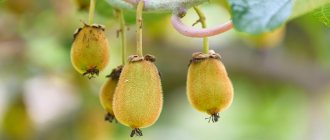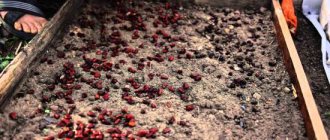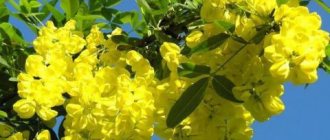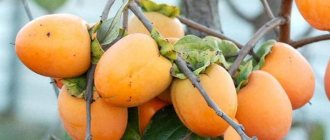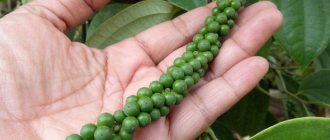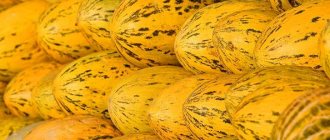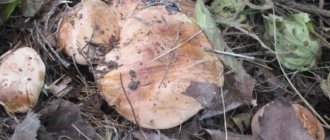Useful properties of kiwi
Kiwi contains many minerals and vitamins. Even citrus fruits contain less vitamin C than kiwi. Kiwi also contains unsaturated acids, antioxidants and disaccharides.
Kiwi, thanks to its beneficial properties, increases resistance to stress and helps cope with fatigue. In addition, nutritionists recommend kiwi to people who want to lose weight, so various diets have been developed based on it.
What tree does kiwi grow on?
The exotic fruit comes from the genus Actinidia, which translates as “ray”. All representatives of the genus have a characteristic radiant arrangement of ovary columns (this is clearly visible if you cut a kiwi crosswise). There are approximately 75 species. They are mainly distributed in Southeast Asia, 4 species can be found in the Russian Far East.
Where kiwi grows - on a tree or bush - is sometimes difficult to answer. Actinidia are considered woody vines, but are sometimes called shrubby vines. However, regardless of whether the kiwi is a tree or a shrub, its fruit is a berry. It combines several flavors, sweet and sour at the same time.
The outside of the berries is unsightly, reminiscent of potatoes covered with lint. The average size of a ripe kiwi is 100 grams. The inside is usually a rich green color. There is a “golden” variety of this plant (Gold kiwi), the fruits of which are yellow in color.
Kiwi reproduction
Growing kiwi at home from seeds is one of the most accessible and popular ways. To do this, you can simply buy a good, fresh fruit in the store and use its seeds.
Below is a brief instruction on how to grow kiwi at home.
Bloom
In April - June (depending on the variety), actinidia is covered with creamy white or pink flowers with a wonderful aroma. Abundant flowering lasts 2-3 weeks. Female and male plants differ in the structure of their inflorescences. Male inflorescences are characterized by the presence of yellow (actinidia kolomikta and polygam) and black (argut) anthers.
Pollination occurs with the help of wind, as well as insects - bumblebees or bees. Pollination of dioecious varieties is possible only if the male and female vines are of the same variety.
After flowering has completed, an ovary forms in the female flowers. The fruits are harvested in August-September. They have an oblong shape, yellow-green or light orange color and a pleasant pineapple smell. The skin of the fruit is smooth or pubescent.
Processing the seeds
First you need to remove the seeds from the fruit and rinse them thoroughly under running water to remove pulp and juice. Kiwi seeds are small, so when washing, use a bandage or gauze as a strainer, or rinse them thoroughly in a container.
Then the seeds need to be germinated. Place the thoroughly washed seeds in a glass of clean water and leave them in a warm place for a week or two until they begin to open. If necessary, you can change the water.
After the seeds open, soak a cloth in water and carefully place them on it. Cover the top with a transparent glass or glass jar and place in a warm and well-lit place.
In such a “mini-greenhouse” the seeds will begin to germinate very soon. When mini-roots become noticeable on them, you can begin replanting into the soil.
Growing conditions
In its natural habitat, actinidia prefers shade, but also likes to be in full sun. The kiwi vine must be protected from the wind, since in the spring, when its gusts can be too strong, damage to young shoots is possible.
When kiwi is grown on an industrial scale, the vines of this plant require a serious hanging system; it will replace the usual natural conditions to which the plant is adapted. The standard version of such a suspension system is a mesh that is attached to supports made of pillars . The main features that must be taken into account when growing kiwi:
- The most favorable soil for growing kiwi is considered to be moderately acidic soil, which is rich in organic matter and has a good drainage system.
- Kiwi categorically does not tolerate saline soil and will not grow there even with good fertilizer.
- Throughout the growing season, the plant needs a large amount of moisture, but under no circumstances should the water stagnate, as this will lead to rotting of the vine and roots.
- During the hot summer period, you need to water the plant regularly, as it does not tolerate dry soil and will quickly die.
The main symptoms of moisture deficiency in kiwi appear instantly in the form of drooping foliage, which begins to dry out along the edges; in addition, the bush can completely shed its leaf cover from young shoots. The most common cause of actinidia death is lack of moisture.
Since this plant is a powerful consumer of nitrogen, during the first half of the growing season it is necessary to fertilize it with nitrogen fertilizers as often as possible. If you use them when the fruiting season is coming to an end, you can increase the size of the fruit itself, but this will directly affect the transportation of products in the future, since it will lead to a deterioration in the safety of the fruit. The plant will benefit greatly from mulching with manure or straw. The mulch should not come into contact with the vine, as this may cause the shoots to rot.
In order for the plant to bear fruit well, it must be pruned for the winter. Despite the fact that actinidia bushes are practically not exposed to diseases and insect attacks, there is still some threat to them. An unusual problem is that the kiwi vine has the same odor as catnip, so it attracts these animals to the plant. This poses a threat because cats can damage the trunks of young plants and thereby cause the death of the kiwi. In addition to the cat, young bushes are often caused problems by garden snails, which absorb the moisture necessary for the vine.
To make it possible to conveniently transport, store and directly sell kiwi fruits, they are selected when the fruit is still hard and not completely ripe. As a result, it does not take in enough sugar, which consequently affects the taste of the product. When kiwi fruits are grown on plantations for personal consumption, they undergo a process of full ripening and only then are harvested.
Planting seedlings
Place a layer of expanded clay drainage at the bottom of the container, then fill it with soil, slightly moistening it. The soil mixture for kiwi should consist of black soil, sand and peat. Carefully place the seedlings and cover them with a thin layer of soil.
How to grow a peach from a pit - care, maintenance and technology for growing peach at home (95 photos)
Coniferous plants in landscape design: how to create a beautiful composition in your garden
Why plums do not bear fruit - 10 main reasons and tips for choosing a method of treating plums and restoring the harvest
Kiwi is a moisture-loving plant, so you should put the container in a warm place and spray it daily. It is also possible to cover the container with film to create a greenhouse effect. The film should be removed after the first shoots appear.
When the seedlings grow (they should reach 10-15 cm and have two leaves), you need to plant them in separate pots. Use the same soil mixture, but with less peat.
Diseases and pests of actinidia
Experts believe that if the vine is properly cared for, it will grow healthy and not at all interesting to pests and diseases. However, some sources dispute this opinion.
For example, it is argued that actinidia leaves are characterized by fungal diseases such as phyllosticosis and ramulariasis: in both cases, dark spots appear on its leaves. Damaged areas of the vine are removed and burned, and the plant itself is treated with a 3% Bordeaux mixture.
- Bordeaux mixture - instructions for the preparation and use of fungicide
Let's understand what Bordeaux mixture is, what it is used for and how to prepare it correctly.
In addition, the vine can be affected by several types of rot at once - late blight root rot, as well as gray or white. All of the listed types of rot occur due to improper care of the vine, its excessive watering, poor aeration and high acidity of the soil. Diseased parts of the plant must be removed and the soil treated with fungicides.
- What are fungicides and what are they used for?
From the article you will learn why you need to treat plants with fungicides and how to apply them correctly.
There are also a number of actinidia diseases that are less common, but more dangerous and require additional control measures.
How to care for a growing kiwi?
A lot of literature has been written about how to plant kiwi at home, but what is much more important is how you care for it during the growth period. Below are brief recommendations for caring for kiwi.
Watering. You need to moisten the kiwi with a spray bottle. In the spring and summer, kiwi should not be moistened less than three times a week; in winter, watering should be reduced to three times a month.
Feeding. Kiwis need to be fed once a year with vermicompost or compost.
Purchasing seeds in bulk: 3 signs of a reliable store
How to propagate plums: the best ways to grow, care and plant with your own hands. Video instructions and 120 photos
At what distance to plant grapes from each other: tips and recommendations from professionals on planting grapes on a personal plot (125 photos and videos)
Lighting. Kiwi loves warmth and light, so you should protect the plant from drafts and place it in a sunlit place, preferably on a south-facing window. You can make up for the lack of light with the help of lamps.
Origin story
It is generally accepted that the first varieties of kiwi were bred and cultivated in China, where this plant was called yang tao (translated from Chinese as strawberry peach). Later, Europeans began to call kiwi "Chinese gooseberry", and this berry began to be in demand around the world.
In order for the fruit to become more in demand on the market, New Zealand producers in 1962 came up with a more attractive name for it, which is assigned to it to this day - kiwi. The producers borrowed the new name from the flightless bird kiwi, which bears a vague resemblance in shape and color to this fruit.
In scientific circles, kiwi is called actinidia. It is quite sensitive to temperature and climate conditions. Even the most insignificant deviations from the temperature norm required by the plant are enough to reduce the level of its flowering, and this entails the destruction of the fruits and the death of the entire plant.
Since kiwi is a rather fastidious plant, the branches of which react very sharply to environmental conditions, many attempts to grow this fruit in different areas and climatic conditions did not bring positive results. On the contrary, producers wishing to grow kiwi suffered significant losses.
Despite the fact that the birthplace of actinidia is Northern China and the coast of Eastern China, where it has been cultivated for three centuries, this fruit has not received much popularity or demand there. This is explained by the limited amount of territory that is suitable for growing the plant on a large scale and the population density on suitable lands. Not so long ago, the actinidia vine was quite common in the natural wild environment; it climbed unhindered through wild trees.
Planting kiwi in open ground
In order for kiwi to take root and bear fruit, before planting you need to be interested in how kiwi grows in nature, under what conditions? Below are recommendations for caring for the plant in open ground.
Landing place. Upland is the best place for kiwi, so that there is no groundwater near the roots. Heavy soil is not suitable for kiwi; it is worth growing kiwi in acidic soil.
Support. Outwardly, kiwi is very similar to a tree with a wide crown, but it is still a vine, so it needs support. A high fence or gazebo will work well, but you can also make a special trellis.
Mulching is mandatory for kiwi. Fertilizer should be placed under mulch or applied in liquid form.
Gooseberry health benefits and harms: beneficial properties for the body and description of the contents of the berry (115 photos + video)
Red currant care and cultivation: varieties, pruning, planting and propagation rules at home (115 photos)
Black elderberry: planting, watering, pruning and propagation. Contraindications, medicinal properties and recipes for feeding elderberry (110 photos)
Watering. Kiwi is a very moisture-loving plant, so abundant watering, especially during the growth period, is mandatory for it.
Description of the kiwi plant and its fruits
In appearance, the kiwi resembles a tree in appearance that requires support. In the natural environment, kiwi fruits, collected in clusters, ripen at the top of the shoots. Throughout the season, the tropical vine changes the color of its leaves from green to white, pink and crimson. This plant is popularly called Chinese gooseberry. The ripe fruit is covered with thin skin and has an amazing taste. Inside the fruit is green, sweetish-sour pulp with numerous small black seeds. Most gourmets associate the taste of this fruit with strawberries, gooseberries, melon, apples or bananas. On average, the weight of one fruit is 80 grams. Kiwi fruits are rich in vitamin C, of which there is more in the fruits than in currants and lemons, and the content of the vital trace element - potassium - is twice as much as in the same bananas.
Kiwi photo
How to choose
In order to get the most out of kiwi, you need to learn how to choose it correctly. When purchasing, pay attention to the following indicators:
- bright fruity aroma;
- the skin should be smooth and elastic;
- a ripe berry should be soft to the touch;
- wrinkled peel indicates loss of moisture and most nutrients;
- There should be no spots or cracks on the peel.
When you bring kiwi home, put it in the refrigerator. There it can lie for up to 4 weeks. If you purchased an unripe fruit, place it in a sunny place and after a couple of days you will receive a ripe, healthy berry.
Harm and contraindications
Before enjoying the fruits of actinidia, be sure to evaluate not only the benefits, but also the harm to the human body, since the tasty berries have specific contraindications for consumption:
- peptic ulcer of the stomach and duodenum;
- allergic manifestations to berries (swelling of the tongue, asthmatic suffocation, dermatosis of the oral mucosa);
- kidney pathology;
- frequent diarrhea;
- poisoning.
Even in the absence of certain contraindications, it is not recommended to abuse the juicy fruits of actinidia, since as a result you can get negative side reactions in the form of nausea, diarrhea, and increased gastric acidity.
